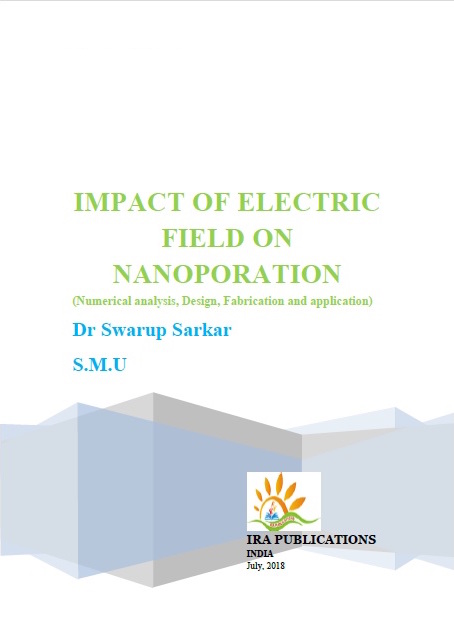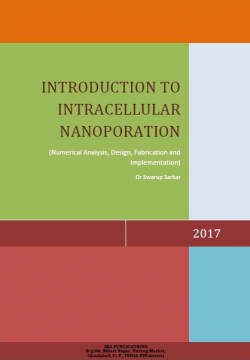Impact of Electric Field on Nanoporation
This book provides the information regarding the Impact of electric field on Nanoporation. This book provides the unique idea for medical and engineering students. It also help the researchers for design and mathematical implementation of micro bio chip which shows the effect of electric field on nanoporation. This book has been divided into ten chapters. The description of the chapter as stated hare under. The first chapter gives a general introduction to electrical properties of biological cell, different electric field and their effect on cell. The second chapter deals with understanding of trans membrane potential which is developed under the influence of electric field. The third chapter deals with window effects of biological cell. The fourth chapter fully dedicated for nanoporation and electrical signals. The main purpose here are to study the analytical and numerical approach of nanoporation of cell under a non-uniform micro-fluidic system under different electrical stimuli .Consequently analyze effects of relevant optimization parameters such as pore current,membrane pressure and surface tension in next three chapters i.e fifth,sixth and seventh chapter. The effect of pressure, surface tension and rest potential on intraorganelle nanoporation are highlighted in chapter eight. Along with this chapter nine contributed the comparative study among the cancer cell and normal biological cell in celluler nanoporation. The last chapter is concentrate the conclusion and modern trends of nanoporation under the different electric field specially impulse pico signals. As a whole This book deals with fundamental concept regarding the effect of electric field on nanoporation within 3D micro fluidic system under electrical stimulation.The results and discussion have the great impact on bio-medical application especially in drug delivery system for pharmacological treatment of different diseases including cancer.
The major highlights of the book are:
a) Numerical and theoretical study of study nanoporation under different electric field.
b) Theoretical explanation of window effects.
c) Design, Fabrication and Implementation of 3D microdevice for nanoporation.
d) Explore of the effect of Pressure, surface tension and rest potential on intracelluler nanoporation under different electric field.
e) Comparative study.
CONTENTS
CHAPTER 1: INTRODUCTION
1.1. Introduction
1.2 Historical Back ground
1.3 Objectives of the books
CHAPTER 2: TRANS MEMBRANE POTENTIAL
2.1 Introduction
2.2 Intra-organelle Potential under different electrical stimuli
2.2.1 Theory
2.2.1.1. Electrical properties of cells
2.2.1.2 Nonlinear electrical dispersive model of biologicalcell
2.2.1.3 Intra organelle transmembrane potential
2.2.1.3.1 Effect of electric pulse specification
2.2.1.3.2 Effect of electrode specification
2.2.1.3.3 Effect of microfloudic channel specification
2.2.1.3.4 Effect of micro fluid specification
2.2.1.4 Effect of medium resistances (𝑅𝑚) and of medium capacitances (Cm)
2.2.2 Simulation tool
2.2.3 Parameters and constant value used
2.2.4 Simulation Results
2.2.4.1 Electrical model of biologicalcell.
2.2.4.2 Calculation of Intraorganelle potential
2.2.4.2.1 Effect of electric pulse field
2.2.4.2.2 Effect of electrode specification
2.2.4.2.3 Effect of channel specification
2.2.4.2.4 Effect of suspension of media
2.2.4.3 Role of different external parameters on intraorganelle potential
2.2.4.3.1 Effect of medium capacitances on membrane potential
2.2.4.4.2 Effect of medium resistances on transmembrane potential in various microelectrode
2.3 Frequency Domain analysis
2.3.1 Simulation results
CHAPTER 3: WINDOW EFFECTS
3.1 Introduction and Defination
3.2 Theoritical Analysis
3.3 Numerical and simulation Study
3.4 Conclusion
CHAPTER 4: NANOPORATION AND ELECTRICAL SIGNALS
4.1 Introduction
4.2 Nanoporative device simulation
4.3 Nanoporative device field simulation
4.4 Analytical study of intraorganelle nanoporation under different electrical stimuli
4.4.1 Theory of nanoporation
4.4.1.1 Radius of nanopores
4.4.1.2 Surface tension
4.4.1.3 Pore density
4.4.1.4 Ion uptake
4.4.2 Numerical simulation
4.4.3. Used parameter
4.4.4 Simulation results and observation
4.4.4.1 Intraorganelle potential
4.4.4.2 Nanopore radius
4.4.4.3 Nanopore density
4.4.4.4 Pore membrane surface tension
4.4.4.5 Ion uptake through nanopore
4.5 Conclusion
CHAPTER 5: ANALYSIS OF PORE CURRENT FOR NANOPORATION
5.1 Introduction
5.2 Theory
5.2.1 Pulse electric field
5.2.2 Micro Electrode
5.2.3 Micro Fluidic Channel
5.2.4 Suspension Media
5.3 Simulation Results and Analysis
5.3.1 Pore current
5.3.1.1 Effect of Pulse
5.3.1.2 Effect of Electrode Specification
5.3.1.3 Effect of Channel Specification
5.3.1.4 Effect of Suspension of Media
5.4 Conclusion
CHAPTER 6: ANALYSIS OF MEMBRANE PRESSURE FOR NANOPORATION
6.1 Introduction
6.2 Theory
6.2.1 Pulse electric field
6.2.2 Micro Electrode
6.2.3 Micro Fluidic Channel
6.2.4 Suspension Media
6.3 Simulation Results and Analysis
5.3.1 Membrane Pressure
5.3.1.1 Effect of Pulse
5.3.1.2 Effect of Electrode Specification
5.3.1.3 Effect of Channel Specification
5.3.1.4 Effect of Suspension of Media
6.4 Conclusion
CHAPTER 7: ANALYSIS OF SURFACE TENSION FOR NANOPORATION
7.1 Introduction
7.2 Theory
7.2.1 Pulse electric field
7.2.2 Micro Electrode
7.2.3 Micro Fluidic Channel
7.2.4 Suspension Media
7.3 Simulation Results and Analysis
7.3.3 Surface tension
7.3.3.1 Effect of pulse
7.3.3.2 Effect of Electrode specification
7.3.3.3 Effect ofChannel specification
7.3.3.4 Effect of suspension of media
7.4 Conclusion
4.4.1 Pore current
4.4.2 Pressure
4.4.3 Surface tension
CHAPTER 8: EFFECT OF PRESSURE, SURFACE TENSION AND REST POTENTIAL ON INTRAORGANELLE NANOPORATION
8.1 Effect of pressure
8.1.1 Effect of pressure on free energy of pore
8.1.2 Effect of pressure on density of pore
8.2 Effect of surface tension
8.2.1 Effect of surface tension on radius of nanopores
8.2.2 Effect of surface tension on density of pores
8.3 Effect of Rest Potential
8.3.1 Effect of rest potential on free energy of pore
8.3.2 Effect of rest potential on radius of nanopores
8.3.3 Effect of rest potential on density of pores
8.4 Conclusion
CHAPTER 9: COMPARATIVE STUDY OF NANOPORATION AMONG BIOLOGICALAND BONE CANCER CELL
9.1 Introduction
9.2 Theoritical Analysis
9.3 Parameter Used
9.4 Simulation Result and Discussion
9.5 Conclusion
CHAPTER 10: CONCLUSIONS AND FUTURE TRENDS
10.1 Conclusion
10.2 Future Trends


 are now available. As low
as ₹120.00 per month.
are now available. As low
as ₹120.00 per month.













